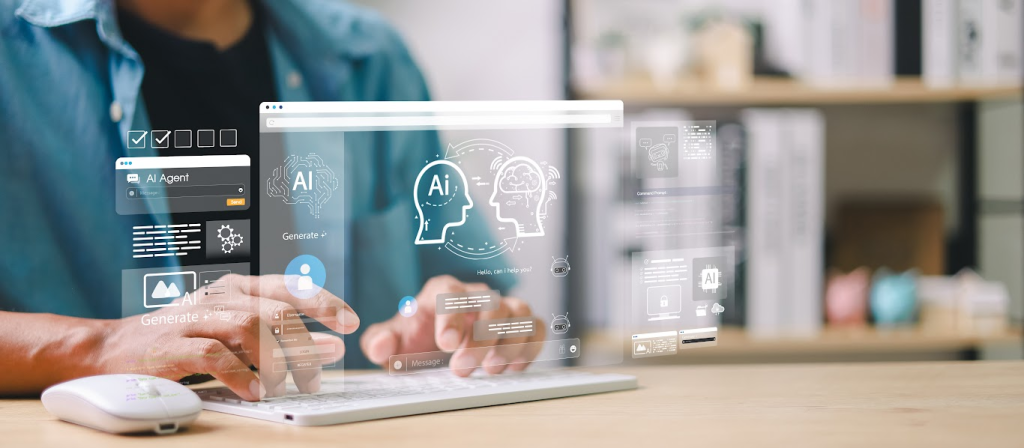What if your digital experiences could evolve by seamlessly adapting to your preferences and behaviors? Read to know how generative AI in UI UX design makes this possible.
Generative AI, with its creativity and flexibility, is transforming almost everything in the world as we know it, and UI UX design is no exception. By simplifying workflows and enabling smart, real-time design solutions, Gen AI is allowing designers to create more user-focused and aesthetically pleasing interfaces.
As AI continues to evolve, it strengthens the fusion of innovation and usability, transforming design into a more intelligent, responsive, adaptive, and accessible process. Generative AI isn’t just a trend; it’s changing how we interact with technology. AI-driven tools now adjust layouts, features, colors, and content based on user behavior and patterns, providing intuitive and efficient digital experiences.
This blog delves into how Generative AI is revolutionizing UI UX design. Starting from its evolution to its major applications, roles, and future potential. By streamlining activities such as wireframing, prototyping, and user testing, AI saves development time while boosting personalization.
Here’s what we cover in this blog:
- What is Generative AI in UI UX Design
- Evolution of UI UX with Gen AI
- Key Applications
- Roles of Generative AI
- Future of Generative AI
- Conclusion
Let’s get started!

What is Generative AI in UI UX Design?
Before we dive deeper, let’s understand what Generative AI is. In simple terms, Generative AI is an AI model that is capable of creating new content, including text, images, and videos. The most commonly used Generative AI tools are ChatGPT, Gemini, and DALL-E.
Generative AI is developed using neural networks, a subset of machine learning. These neural networks are like neurons in human brains, which enable the system to learn through experience and improve over time.
With its adaptive, intelligent, and innovative interfaces, Generative AI is transforming the UI UX design space. It automates the design process, generates sample experiences, and optimizes user interaction in real time.
AI-powered tools enhance prototyping, wireframing, and user testing while reducing the time taken for development as well as ensuring designs are responsive and accessible. Employing its understanding of user behavior, generative AI dynamically refines layouts, color schemes, and content to promote intuitive and engaging digital experiences.
This tech also helps with predictive design and envisioning what the user needs for seamless navigation. Gen AI equips designers with a creative vision of building user-centric interfaces that are efficient and aesthetically pleasing.

Evolution of UI UX Design
UI UX design has gone through a significant level of transformation. It has evolved from static layouts to highly interactive and adaptive interfaces. Traditional design methods required extensive manual effort, but with the advent of generative AI, the process has become more automated, intelligent, and user-driven.
Let’s take an overall look at how UI UX Design has evolved over the years:
- 1990s: This marked the birth of web design. The layouts were often very simple and static, and they were made using basic HTML and CSS. These layouts offered minimal interactiveness.
- 2000s: More interactive layouts were introduced; made possible due to JavaScript frameworks and advancements in CSS.
- 2010s: This era introduced AI-powered analytics, which helped designers understand user preferences. This let designers offer exactly what users wanted, ushering in a time of hyper-personalization.
- Present Day: It is all about the AI revolution. Designers are increasingly using Generative AI tools for real-time personalization, more adaptive interfaces, and predictive analytics to understand user behavior.
With Gen AI becoming more mainstream than ever, its applications in the UI UX Design space has diversified manifold. Let’s move on to understanding a few of these in the next section.

Key Applications of Generative AI in UI UX Design
From faster design iterations to in-depth analysis of what users expect from an interface, Gen AI finds several uses within UI UX Design. A few of these are:
1. Automating the Design Iteration Process
Designers may produce several layout, interface, and graphic element variations in a fraction of the time with AI-powered generative design tools. Instead of manually crafting each version, AI algorithms analyze design prompts, user behavior, and industry trends to generate optimized solutions.
Designers can then review and refine these AI-generated designs, boosting productivity while maintaining consistency across digital platforms. Additionally, generative AI enables continuous improvements by dynamically adapting designs based on emerging trends and user interactions.
2. Improving Content Creation
Content is a crucial element of UI UX design and influences user interaction and engagement. Generative AI enhances content development and assists designers in achieving their objectives by producing language that is compelling, understandable, and search engine optimized. It ensures that content on apps and websites remains relevant, engaging, and tailored to user preferences.
AI-powered content solutions can also automate text formatting, localization, and personalization, making digital interfaces more interactive and accessible. Consequently, the content on an interface is more unified and user-centered across all platforms.
3. Customizing Prototypes
Prototyping is a crucial step in the UI UX process that allows designers to test and refine concepts before finishing a design. AI-powered prototype tools suggest layouts, design components, and interaction patterns based on historical data and real-time feedback.
This automation speeds up the development cycle by reducing the amount of time needed for multiple design revisions. By incorporating AI into prototypes, designers can quickly adapt to client preferences, ensuring a seamless and productive user experience.
With the advent of generative AI in UI UX design, businesses can create more creative, customized, and adaptable digital experiences that significantly improve consumer satisfaction and engagement.

Role of Generative AI in UI UX Design
Generative AI is revolutionizing UI UX design, making digital experiences more innovative, efficient, and customized. Through the automation of crucial design processes, the promotion of creativity, and the real-time optimization of user interactions, it enhances the usability and appeal of interfaces.
1. Optimizing User Experiences
Generative AI enhances the user experience by continuously suggesting changes to UI elements based on user choices and behavior. By utilizing AI-driven recommendation algorithms to customize content, companies like Netflix and Spotify demonstrate how AI can be critical to personalizing digital interactions.
To improve inclusivity and interaction, AI adjusts themes, layouts, and navigational structures in response to user input. This customized method makes interfaces more engaging and user-friendly by guaranteeing that users receive content and design elements that are tailored to their demands.
2. Enhancing Creativity and Innovation
Generative AI fosters creativity by allowing designers to experiment with new themes, design concepts, and UI components. With the use of tools like Figma’s AI-driven design assistants, which provide innovative recommendations, designers can now push the boundaries of creativity.
AI makes it easier to create unique layouts that improve color schemes, satisfy user expectations, and boost aesthetics. By eliminating monotonous design tasks, AI frees up designers’ time to focus on innovations and user development.
3. Real-Time User Interaction Optimization
Artificial intelligence (AI) is essential for improving user interactions through continuous behavior monitoring and analysis. Updating interface components dynamically improves user engagement and navigation.
AI-powered interfaces that respond in real time to user input ensure smooth transitions, personalized recommendations, and easy design changes. This continuous development makes digital platforms more efficient and engaging, which ultimately increases user satisfaction.
Generative AI is transforming UI UX design by facilitating creative invention, automating procedures, and personalizing experiences. For UI UX designers looking to stay ahead in this rapidly evolving field, enrolling in a generative AI course is a good call. These courses offer hands-on learning to leverage AI’s potential, as well as help understand foundational concepts and deep learning models. Mastering data science and generative AI is essential to cash into design career opportunities within businesses that are increasingly relying on data-driven strategies.

The Future of Generative AI in UI UX Design
Through constant behavior monitoring and analysis, artificial intelligence (AI) plays a critical role in enhancing user interactions. It betters navigation and user engagement by providing insights into dynamic updates on interface elements. AI-driven interfaces that are able to react to user input in real-time, can help designers guarantee seamless transitions, tailored suggestions, and simple design modifications made on-the-go.
1. AI-Driven Personalization
Hyper-personalized user experiences will be made possible by future AI models that analyze behavior in real time. In order to improve user engagement, interfaces will dynamically adjust their layouts, color schemes, and information. Predicting user preferences using AI-driven design will guarantee smooth navigation and optimal interactions. Digital platforms will consequently become more user-friendly and precisely meet the needs of each user.
2. Advanced Prototyping and Automation
Prototyping will be transformed by AI-powered technologies that automate wireframing and cut down on development time. Automated systems will anticipate user requirements and make instantaneous interface improvement suggestions. The iteration process will be streamlined as a result, enabling designers to test and adjust designs more effectively. In the near future, AI will work with humans to create dynamic, user-centric interfaces that have a much more in-depth understanding of user behaviour and needs.
3. Ethical and Inclusive Design
AI-powered design frameworks will be essential for advancing inclusion and accessibility. AI will assist in developing interfaces that accommodate a variety of user groups by lowering biases in UI UX Design. Design workflows will incorporate ethical AI principles to ensure fairness and transparency, which will ultimately increase consumer confidence in digital products.
4. The Role of Learning in AI Evolution
Designers need to continuously improve their skills as AI technology develops in order to remain competitive in a changing digital environment. Professionals hoping to realize AI’s full potential will need to comprehend AI-enhanced design processes. Designers can develop their knowledge of AI-driven automation, customization, and ethical design principles by enrolling in a course or going through resources that speak of AI’s increasing role in design.
Professionals can learn how to develop data-driven solutions and adaptable user experiences that follow market trends by getting practical experience with AI technologies. To keep designers at the forefront of UI UX developments, continuous learning is needed to bridge the gap between AI innovation and human invention.

Conclusion
Generative AI is revolutionizing UI UX design by enabling the creation of innovative, smart, efficient, and adaptable digital user interfaces. From automating design workflows to enhancing customization and real-time prototyping, AI-driven technologies are reshaping how users interact with digital products. These tools not only reduce development time but also help deliver smoother, more intuitive user experiences.
As AI continues to evolve and integrate deeper into design processes, the role of designers will become even more crucial. To harness AI’s full creative potential of crafting inclusive, accessible, and truly user-centric interfaces, human intervention will always be needed. When done right, this synergy between AI and human creativity doesn’t just meet user expectations- it delivers engaging, memorable, and deeply satisfying digital experiences.
Next Steps
If you’d like to learn more about UI UX design, check out more of our articles on the AND Academy Design Blog. You can also check out this project by AND Learner, Vikas Sen, for more insights into the applications of UI UX design.
In case you think you need further assistance, here are some of our resources you can consider:
- Watch this session by Shiva Viswanathan, Design Head of Ogilvy Pennywise, and Naman Singh, Product Experience Designer at RED.
- Talk to a course advisor to discuss how you can transform your career with one of our courses.
- Pursue our UI UX Design courses – all courses are taught through live, interactive classes by industry experts, and some even offer a Job Guarantee.
- Take advantage of our scholarship and funding options to overcome any financial hurdle on the path of your career transformation.
Note: All information and/or data from external sources is believed to be accurate as of the date of publication.









